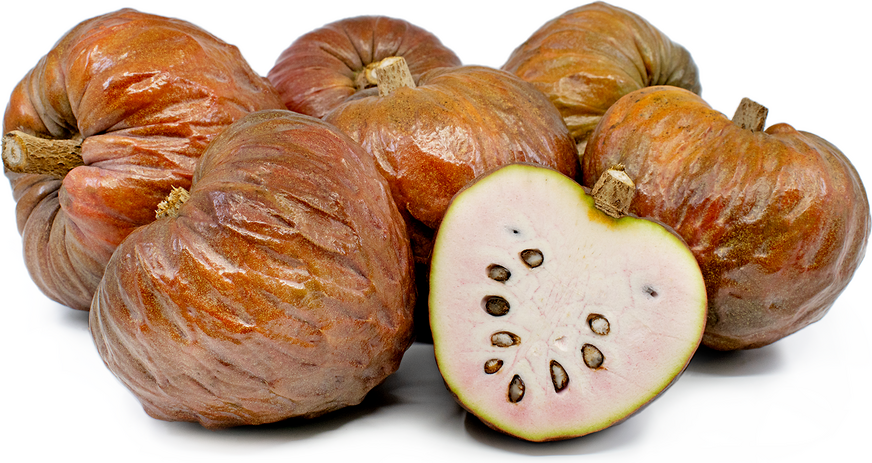


Bullock's Heart
Estimated Inventory, ea : 0
Description/Taste
The Bullock’s Heart is roughly 8-16 centimeters long and can be symmetrically heart-shaped or more rounded and lopsided with a deep or shallow depression at the base. The thin skin has a velvety appearance and is covered with scaly depressions. When fully ripe it develops a brownish color with a pink or reddish blush. There is a thick, cream-white layer of custard-like flesh beneath the skin surrounding the fruit’s juicy segments. In each segment there is a single hard black seed which is toxic and should not be consumed. The ripe fruit’s flavor is sweet, succulent, and musky, without the distinct floral character of its cousins the cherimoya and atemoya.
Seasons/Availability
Bullock’s heart is available in summer and fall.
Current Facts
The Bullock’s Heart, or Bull’s Heart, is a tropical tree fruit that received its name due to its resemblance to a bull's heart. It also shares the alias “custard apple” with its relatives the cherimoya and atemoya. In India the widely used Bullock’s Heart is known as ramphal. It is botanically classified as Annona reticulata and belongs to the Annonaceae, or custard apple, family.
Nutritional Value
The Bullock’s Heart is tasty as well as nutritional. It is very low in calories and free of fat, sodium, and calcium. One ounce of the raw fruit contains 6% of one’s daily value of Vitamin C, 3% of Vitamin B6, 2% of Riboflavin, as well as small amounts of calcium, magnesium, iron, phosphorous, and potassium.
Applications
The sweet flavor of the Bullock’s Heart is best enjoyed in desserts or on its own. For an easy treat simply scoop the flesh from the skin, press through a sieve to remove the toxic seeds, and enjoy plain or with a dash of sugar and cream. The strained flesh is also a delectable addition to milky desserts such as ice cream, custard, and milkshakes, and can also be made into a sauce by blending the fruit with cream and mashed banana.
Ethnic/Cultural Info
People around the world enjoy the Bullock’s Heart not only for its culinary attributes but also for its array of medicinal, agricultural, and homesteading uses. Its seeds, leaves, and young fruits have insecticidal properties, the leaves are used for tanning leather and to create a black or blue dye, fiber can be obtained from the tree’s young twigs, and its yellow wood has been utilized in the construction of oxen yokes. Its many applications in folk medicine include a tea made from the leaves employed to treat intestinal worms, a poultice of leaves and fruit flesh which treats abscesses, and a decoction of the roots that is recommended as a fever remedy. Please note that the above medicinal information is shared for educational purposes only.
Geography/History
The Bullock’s Heart tree is believed to be native to the West Indies, though it has long been cultivated in Central America and much of South America. It was brought to Africa in the early 1600’s and was later brought to India, Guam, and many other tropical areas throughout the world.
Recipe Ideas
Recipes that include Bullock's Heart. One
| Shockingly Delicious |
|
Cherimoya Ice Cream |




